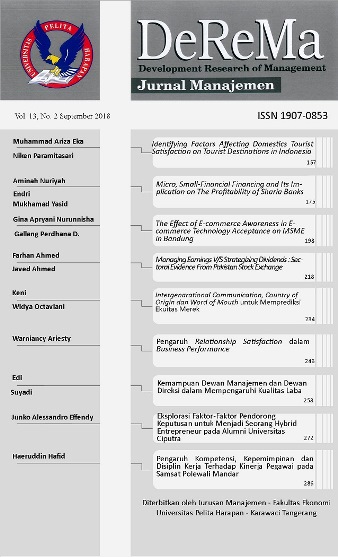Identifying Factors Affecting Domestic Tourist Satisfaction of Tourist Destinations in Indonesia
DOI:
https://doi.org/10.19166/derema.v13i2.792Λέξεις-κλειδιά:
Domestic Tourist Satisfaction, Indonesian TourismΠερίληψη
The objective of this study was to identify the factors affecting domestic tourist satisfaction of tourist destinations. The type of this study was a quantitative descriptive study using Cochran Q test and factor analysis of tourist satisfaction drivers factors. The result of this study showed that there were 38 attributes affecting domestic tourist satisfaction in Indonesia. The first rank was the beauty of natural attractions; the second rank was artificial tourism attractions; and, the third rank was the cost and cleanliness of facilities and environment of tourism destinations. Furthermore, all these attributes were clustered into several factors: attraction, amenities, accessibility, hospitality, and ancillary. The significance of this study is that the identified factors are beneficial for stakeholders as the indicators of customer satisfaction.
Abstrak dalam Bahasa Indonesia : Tujuan penelitian ini adalah untuk mengidentifikasi faktor-faktor yang mempengaruhi kepuasan wisatawan domestik terhadap suatu destinasi wisata. Jenis penelitian ini adalah penelitian deskriptif kuantitatif, menggunakan alat analisis Cochran Q test dan analisis faktor terhadap faktor-faktor pendorong kepuasaan wisatawan. Hasil penelitian ini menunjukkan terdapat 38 atribut yang mempengaruhi kepuasan wisatawan domestik di Indonesia. Lebih lanjut diperoleh ranking pertama ditempati oleh keindahan obyek wisata alam, ranking kedua ditempati oleh daya tarik wisata buatan dan ranking tiga ditempati oleh tingkat harga dan kebersihan fasilitas dan lingkungan destinasi wisata. Kegiatan penelitian kemudian dilanjutkan dengan pengelompokan atribut menjadi faktor-faktor, dimana ditemukan 5 faktor utama yaitu attraction, amenities, accessibility, hospitality dan ancillary. Pentingnya penelitian ini adalah bahwa faktor-faktor yang teridentifikasi bermanfaat bagi para pemangku kepentingan sebagai indikator kepuasan pelanggan.
Αναφορές
Beattie, J. M., & Schneider, I. E. (2018). Does service type influence satisfaction? A case study of Edinburgh Castle. Tourism Management, 67, 89-97. https://doi.org/10.1016/j.tourman.2018.01.005
Chi, C. G.-Q., Pan, L., & Del Chiappa, G. (2018). Examining destination personality: Its antecedents and outcomes. Journal of Destination Marketing & Management, 9, 149-159. https://doi.org/10.1016/j.jdmm.2018.01.001
De Frantz, M. (2017). Tourism marketing and urban politics: Cultural planning in a European capital. Tourism Geographies, 20(3), 481-503. https://doi.org/10.1080/14616688.2017.1354392
DedeoÄŸlu, B. B., Van Niekerk, M., Weinland, J., & Celuch, K. (2018). Re-conceptualizing customer-based destination brand equity. Journal of Destination Marketing & Management. https://doi.org/10.1016/j.jdmm.2018.04.003
Dolnical, S., & Ring, A. (2014). Tourism marketing research:Past, present and future. Annals of Tourism Research, 47, 31-47. https://doi.org/10.1016/j.annals.2014.03.008
Garcia Henche, B. (2018). Urban experiential tourism marketing. Journal of Tourism Analysis, 25(1), 2-22. https://doi.org/10.1108/JTA-01-2018-0002
Goeldner, C., & Ritchie, J. R. B. (2012). Tourism: Principles, practices, philosopies (12th ed.). New Jersey: John Wiley & Sons,Inc.
Hanna, P., Font, X., Scarles, C., Weeden, C., & Harrison, C. (2017). Tourist destination marketing: From sustainability myopia to memorable experiences. Journal of Destination Marketing & Management, 9, 36-43. https://doi.org/10.1016/j.jdmm.2017.10.002
Hasan, A. (2015). Tourism marketing. Yogyakarta, Indonesia: Center for Academics Publishing Service.
John, S., Larke, R., & Kilgour, M. (2018). Applications of social media for medical tourism marketing: An empirical analysis. Anatolia, 1-13. https://doi.org/10.1080/13032917.2018.1473261
Kebudayaan & Pariwisata Dalam Angka Tahun 2013. (2013). Dinas Kebudayaan & Pariwisata Propinsi Lampung.
Kotler, P., & Keller, K. L. (2009). Manajemen Pemasaran Edisi Ketiga Belas. Jakarta, Indonesia: Erlangga.
Kotsi, F., Balakrishnan, M. S., Michael, I., & Ramsøy, T. Z. (2018). Place branding: Aligning multiple stakeholder perception of visual and auditory communication elements. Journal of Destination Marketing & Management, 7, 112-130. https://doi.org/10.1016/j.jdmm.2016.08.006
Mainolfi, G., & Marino, V. (2018). Destination beliefs, event satisfaction and post-visit product receptivity in event marketing. Results from a tourism experience. Journal of Business Research. https://doi.org/10.1016/j.jbusres.2018.03.001
Middleton,T. C. V., Fyall, A., & Morgan, M. (2009). Marketing in travel & tourism (4th ed.). London: Elsevier Ltd.
Omar, M. S., Ariffin, H. F., & Ahmad, R. (2016). Service quality, customers’ satisfaction and the moderating effects of gender: A study of Arabic restaurants. Procedia - Social and Behavioral Sciences, 224, 384-392. https://doi.org/10.1016/j.sbspro.2016.05.393
Pender, L., & Sharpley, R. (2005). The management of tourism. Thousand Oaks, CA: Sage.
Rafiei Darani, H., & Asghari, H. (2018). Study of international tourism demand in Middle East by panel data model. International Journal of Culture, Tourism and Hospitality Research, 12(1), 80-88. https://doi.org/10.1108/IJCTHR-03-2017-0030
Rencana Strategis (Renstra) Parwisata Lampung Tahun 2010-2014. (2012). Dinas Kebudayaan & Pariwisata Propinsi Lampung.
Sangpikul, A. (2018). The effects of travel experience dimensions on tourist satisfaction and destination loyalty: The case of an island destination. International Journal of Culture, Tourism and Hospitality Research, 12(1), 106-123. https://doi.org/10.1108/IJCTHR-06-2017-0067
Serra-Cantallops, A., Ramon-Cardona, J., & Salvi, F. (2018). The impact of positive emotional experiences on eWOM generation and loyalty. Spanish Journal of Marketing - ESIC. https://doi.org/10.1108/SJME-03-2018-0009
Simamora, B. (2007). Panduan riset perilaku konsumen. Jakarta, Indonesia: Gramedia Pustaka Utama.
Singagerda, F. S., & Septarina, L. (2016). The economy of tourism and its impact to other sectors in Lampung Province. Journal of Indonesian Tourism and Development Studies, 4(3), 129-136. https://doi.org/10.21776/ub.jitode.2016.004.03.06
SmolÄić Jurdana, D., & Soldić Frleta, D. (2016). Satisfaction as a determinant of tourist expenditure. Current Issues in Tourism, 20(7), 691-704. https://doi.org/10.1080/13683500.2016.1175420
Sotiriadis, M. D. (2017). Sharing tourism experiences in social media. International Journal of Contemporary Hospitality Management, 29(1), 179-225. https://doi.org/10.1108/IJCHM-05-2016-0300
Stangl, B., & Prayag, G. (2017). Collaborative destination marketing and PWYW. Annals of Tourism Research, 70, 103-104. https://doi.org/10.1016/j.annals.2017.09.001
Stylidis, D., & Cherifi, B. (2018). Characteristics of destination image: Visitors and non-visitors’ images of London. Tourism Review, 73(1), 55-67. https://doi.org/10.1108/TR-05-2017-0090
Swarbrooke, J., & Horner, S. (2007). Consumer behaviours in tourism (2nd ed.). London: Elsevier Ltd.
Tsiotsou, R., Tsiotsou, R. H., & Ratten, V. (2010). Future research directions in tourism marketing. Marketing Intelligence & Planning, 28(4), 533-544. https://doi.org/10.1108/02634501011053702
Xu, X. (2018). Does traveler satisfaction differ in various travel group compositions? International Journal of Contemporary Hospitality Management, 30(3), 1663-1685. https://doi.org/10.1108/IJCHM-03-2017-0171
Yusendra, M. A. E., 2015. Analisis faktor-faktor yang mempengaruhi keputusan pemilihan destinasi wisata bagi wisatawan domestik nusantara. Jurnal Manajemen Magister Darmajaya, 46-64.
Zhang, T., Abound Omran, B., & Cobanoglu, C. (2017). Generation Y’s positive and negative eWOM: Use of social media and mobile technology. International Journal of Contemporary Hospitality Management, 29(2), 732-761. https://doi.org/10.1108/IJCHM-10-2015-0611
Λήψεις
Δημοσιευμένα
Τεύχος
Ενότητα
Άδεια
Authors who publish with this journal agree to the following terms:
1) Authors retain copyright and grant the journal right of first publication with the work simultaneously licensed under a Creative Commons Attribution License (CC-BY-SA 4.0) that allows others to share the work with an acknowledgement of the work's authorship and initial publication in this journal.
2) Authors are able to enter into separate, additional contractual arrangements for the non-exclusive distribution of the journal's published version of the work (e.g., post it to an institutional repository or publish it in a book), with an acknowledgement of its initial publication in this journal.
3) Authors are permitted and encouraged to post their work online (e.g., in institutional repositories or on their website). The final published PDF should be used and bibliographic details that credit the publication in this journal should be included.





